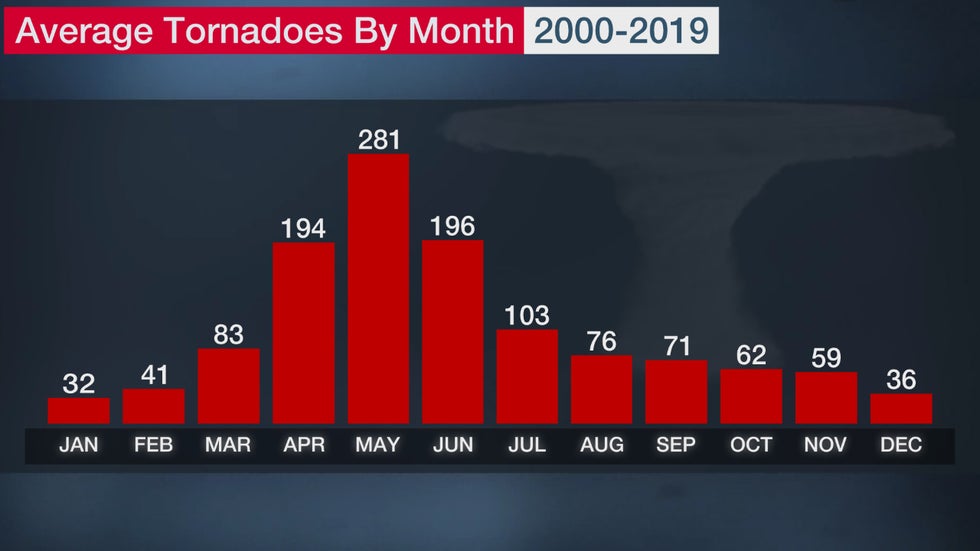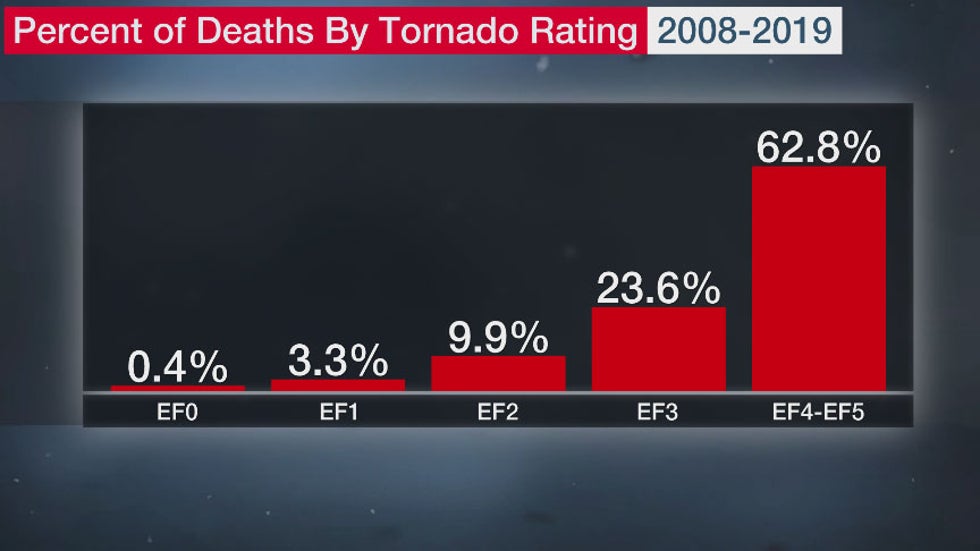Chris Dolce
April kicks off what is typically the most active and dangerous three months of the year for tornadoes in the United States.
As 2021 has already proven, damaging tornadoes can strike in any month. March had a series of severe weather outbreaks in the South, but deadly tornadoes also struck the region in January and February.
But weather history shows April, May and June are the months with the most potential of having both the greatest number of tornadoes and the most intense tornadoes.
The U.S. averaged 1,234 tornadoes annually from 2000 to 2019. About 54% of those tornadoes happened from April to June.
The most tornadoes typically happen in May, with an average of 281. This is followed by June and April, which average 196 and 194 tornadoes per year, respectively.
 April-June average the most number of tornadoes during the year.
April-June average the most number of tornadoes during the year.Of course, these are averages and the actual outcome can vary for how tornadic these months are in a given year. Last year is a good example of this.
Following one of the most active Aprils on record, May and June went mostly silent in 2020.
Shop the Spring Sale at Nordstrom (SPONSORED)
Just 10 tornado watches were issued in May 2020, the fewest for the month in 50 years of records, according to NOAA's Storm Prediction Center. The preliminary tornado count for May was less than half of the 20-year average.
An Easter outbreak in April 2020 spawned more tornadoes in two days (140) than the preliminary total for both May and June.
Tornado Threat Migrates From South to Plains, Midwest
Tornadoes are more common in spring compared to other months because the required atmospheric ingredients come together more often this time of year.
Outbreaks of tornadoes occur when a storm system propelled by a strong, southward dip in the jet stream punches into the Plains, Midwest or South. This is accompanied by warm and humid air flowing northward out of the Gulf of Mexico.
Historically, the greatest threat of tornadic thunderstorms has migrated from the South into parts of the Plains and Midwest as the year progresses deeper through spring and into early summer.
The reason for this is that the jet stream begins to make its annual northward retreat toward the Canadian border. The jet stream provides deep wind shear, or changing wind speed and direction with height, supportive of rotating supercell thunderstorms.
If wind shear is particularly strong in the first few thousand feet near the surface, these supercells would more likely produce tornadoes.
That's why the potential for tornadoes in the South is much lower in June compared to April. Although moisture is abundant across the southern region in late spring, the strong jet stream needed to help make conditions favorable for tornadic thunderstorms is usually absent.
(MORE: Tornado Risk By Month)
 Average tornado risk for April, May and June.
Average tornado risk for April, May and June.Tornado Intensity Is a Factor in Spring, Too
The sheer number of tornadoes from April through June isn't the only thing that makes this such a dangerous time of year – tornado intensity is also a factor.
About 58 percent of all twisters rated F3/EF3 or stronger (1950-2012) touched down in those three months, according to statistics compiled by Dr. Greg Forbes, a former severe weather expert for The Weather Channel. This rises to 69 percent when examining tornadoes F4/EF4 or stronger.
Shop Outdoor Dining Sets Starting at $150 (SPONSORED)
The most violent F5/EF5 rating has been assigned to 59 tornadoes dating back to 1950, and all but 10 of those occurred in April, May or June.
All tornadoes pose a threat, but intense twisters account for a higher number of fatalities and damage. About 86 percent of the deaths from 2008 through 2019 were from tornadoes rated EF3 or stronger, according to NOAA's Storm Prediction Center.
 The largest percentage of tornado deaths are caused by twisters rated EF3-EF5.
The largest percentage of tornado deaths are caused by twisters rated EF3-EF5.The Weather Company’s primary journalistic mission is to report on breaking weather news, the environment and the importance of science to our lives. This story does not necessarily represent the position of our parent company, IBM.
The Weather Company’s primary journalistic mission is to report on breaking weather news, the environment and the importance of science to our lives. This story does not necessarily represent the position of our parent company, IBM.

No comments:
Post a Comment